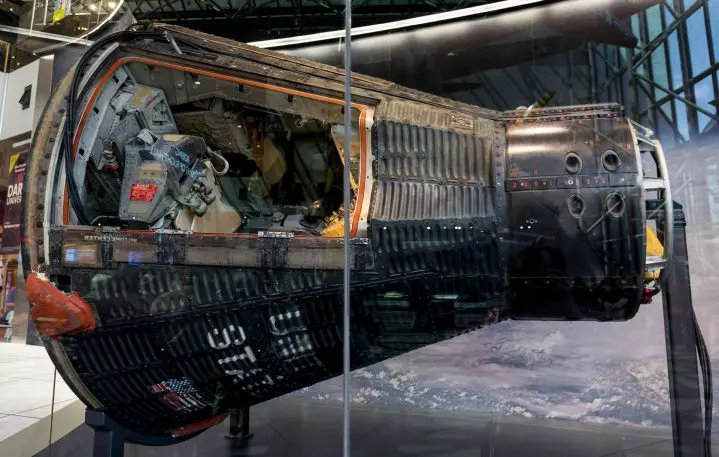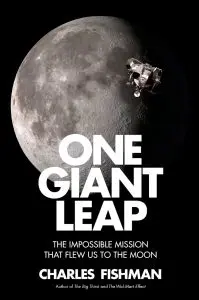This is the 41st in an exclusive series of 50 articles, one published each day until July 20, exploring the 50th anniversary of the first-ever Moon landing. You can check out 50 Days to the Moon here every day.
One of the most important parts of flying in space is something called rendezvous: bringing two spaceships together out in space, while they are in orbit—whether around the Earth, the Moon, or any other planetary body.
When the space shuttle flew to the International Space Station, and then docked with it, that’s rendezvous. The space shuttle did that over and over, of course, dozens of times. Today, the Russian Soyuz spacecraft flies to the space station with astronauts, as do the robotic resupply ships from SpaceX. They are all rendezvousing with the space station—flying into orbit themselves, then maneuvering to dock with the station.
Way back in July 1969, when Apollo 11 moonwalkers Neil Armstrong and Buzz Aldrin were finished with their visit to the Moon—which lasted just 22 hours—their job was to blast off in the upper stage of the lunar module and fly back up to meet the command module, which had stayed in orbit around the Moon, piloted by Michael Collins.
The lunar module had to lift off from the Moon, fly up to the right altitude and the right orbit, and then zero in on Collins and dock with the command module, at which point Armstrong, Aldrin, and their Moon rocks would transfer over to the capsule for the ride back to Earth.
Without that kind of rendezvous, there is no real, useful space travel.
So while it’s easy to describe, it turns out to be devilishly difficult to do, despite the fact that it’s become routine. It is so hard, requires so much math, and works so differently from movement on Earth, that for a long time NASA wasn’t sure it could be done safely.
The weirdness of navigating in space
In simple terms, rendezvous is no different from a tugboat leaving the pier and heading out to a freighter it needs to guide into port. The tugboat has to know the location of the freighter, it has to know its own location, it has to know in what direction the freighter is moving and how fast.
Although we live in a three-dimensional world, that rendezvous between a freighter and a tugboat is really happening in two dimensions: on the surface of the water. You can sense what direction the freighter is moving, or see what direction it is moving, by its bow wave and the things it passes. You can sense its speed. You can sense your own speed, and you have decades of experience judging the distance between you and other objects in the world. To catch the freighter, you throttle up and make sure you’re going faster than it. As you approach, you throttle back so you don’t overtake the ship, and you ease in, matching its speed to pull alongside, tie up, and do your job.
Even if you don’t pilot ships on the ocean, you can imagine how that would work.
But rendezvous in space is completely different.
Here’s how different it is, in one disorienting example. Say you’re piloting the space shuttle in orbit, and you want to dock with the International Space Station. Well, if you spy it out the cockpit window, then aim and zoom toward it—giving the shuttle some extra rocket thrust to swoop in alongside the docking port—you’ll instantly discover two things: When you give the shuttle more power, you’ll fly faster but you’ll also end up farther from the Space Station, and you’ll go higher in orbit. That is, if you rocket toward the thing you want to catch in orbit, you will end up farther from it. The way to catch up to something in orbit is, confoundingly, to slow down.
In fact, rendezvous in space is a kind of puzzle, where you have to start at the ending and work backward. If there’s a space station in orbit, and I want to get my spaceship to it, where do I have to put my spaceship so that as I either slow down or speed up, the space station gets closer and closer to me, and we are able to meet at a point in space?
That is just the start of the weirdness of navigating in space. Your human intuition—based on 30 or 40 years of living on Earth and rendezvousing with things all the time: a doorway, the curb, freeway entrance ramps—is not only useless in space but it also tells you to do the wrong thing.

The people in charge of figuring out how to fly to the Moon knew all that. They knew that rendezvous in space was going to be something humans had to figure out how to do. First, they’d do it with equations—on paper. Then they would have to struggle to learn in space itself. You have to work out the plan in advance, and then you have to follow it—or you stand no chance of success.
Dave Scott, the astronaut who commanded Apollo 15, spent four years flying jet fighters for the Air Force. Then, from 1960 to 1962, he went to MIT and got two graduate degrees, in aeronautics and astronautics. He knew flying. He knew the theory and practice of orbital mechanics before becoming an astronaut. But rendezvous was so daunting, Scott remembers, that “when I was studying at MIT, the ability to rendezvous in space was an issue for debate. It wasn’t clear whether it was possible to develop the mathematics and speed of computation necessary to bring two vehicles together at a precise point in space and time.”
Gemini 4’s futile rendezvous attempt
In the early days of spaceflight, rendezvous wasn’t just hard and counterintuitive; it was scary. NASA feared that a failed rendezvous at the Moon, for instance, would leave two astronauts in the lunar module, orbiting in the wrong place, out of fuel—and therefore, doomed.
NASA’s first effort to use astronauts to rendezvous failed, and failed spectacularly, in just the way one might have imagined for a species of gravity-bound, novice space travelers.
Gemini 4 was a four-day mission launched June 3, 1965, with astronauts Ed White and Jim McDivitt. It was only the second Gemini flight with astronauts, and it was the first U.S. space mission to last more than a day.
It featured the first U.S. spacewalk, with White floating outside the capsule for 20 minutes and enjoying it so much that he had to be ordered back into the spaceship by flight director Chris Kraft taking over the radio and hollering, “The flight director says, Get back in!”
McDivitt and White were the first astronauts—Russian or American—to attempt a rendezvous in space. Their goal was to rendezvous their capsule with the used second stage of the Titan rocket that had helped launch them. Just after separating from the booster, as they entered orbit, McDivitt made a first stab at rendezvous. The official NASA history of the Gemini program, On the Shoulders of Titans, tells what happened: “McDivitt braked the spacecraft, aimed it, and thrusted toward the target. After two bursts from his thrusters, the booster seemed to move away and downward. A few minutes later, McDivitt pitched the spacecraft nose down and the crew again saw the rocket, which seemed to be traveling on a different track. He thrusted toward it—no success—and stopped. McDivitt repeated this sequence several times with the same luck.”
To mission control, McDivitt reported, “The booster fell away quite rapidly and got below us like there was a considerable difference in our velocity.” The booster wasn’t moving away, of course; it was McDivitt’s spaceship that was moving away, following the laws of orbital mechanics.
McDivitt and White tried again after passing through darkness. No luck. The booster stage had only two lights on it, and McDivitt had trouble assessing how far away it was. Their Gemini capsule had no radar to help them judge the distance.
McDivitt estimated that he started out a few hundred feet from the booster. After 45 minutes of trying to get to it, he radioed CapCom Gus Grissom at mission control: “I think we ought to knock it off, Gus. It keeps falling. It’s probably three or four miles away, and we just can’t close on it.”

McDivitt was a highly experienced Air Force pilot—10 years, including 145 combat missions in the Korean War. From the crew debriefing after the flight, two things are clear: He had learned the theory and math of orbital mechanics, and he had been taught what the correct maneuvers were to be able to rendezvous. But when it came down to it, when he was at the controls of his spaceship looking at that booster out the capsule window, he just didn’t buy those instructions.
He tried to fly in space using instincts ingrained on Earth.
“I thrusted right at the booster again,” he said in the debriefing, “did it three or four times . . . . I thrusted some more right at the booster, trying to just overcome orbital mechanics with brute force . . . . It was too late to start playing fancy games with the orbital mechanics.”
Eventually, McDivitt said, “It looked like a hopeless task and that we had better stop this stuff or we were going to lose all the fuel for the whole mission.”
NASA would perform a successful rendezvous between two Gemini spacecraft just six months later. McDivitt would go on to command Apollo 9, the first test flight of the lunar module in orbit with astronauts at the controls. Apollo 9 was a huge success. McDivitt flew the lunar module 111 miles away from the command module in Earth orbit and then returned for a pinpoint docking.
McDivitt had learned to fly in space by surfing along with the rules of orbital mechanics rather than trying to beat them.

Charles Fishman, who has written for Fast Company since its inception, has spent the past four years researching and writing One Giant Leap, his New York Times best-selling book about how it took 400,000 people, 20,000 companies, and one federal government to get 27 people to the Moon. (You can order it here.)
For each of the next 50 days, we’ll be posting a new story from Fishman—one you’ve likely never heard before—about the first effort to get to the Moon that illuminates both the historical effort and the current ones. New posts will appear here daily as well as be distributed via Fast Company’s social media. (Follow along at #50DaysToTheMoon).
Recognize your brand’s excellence by applying to this year’s Brands That Matter Awards before the early-rate deadline, May 3.
